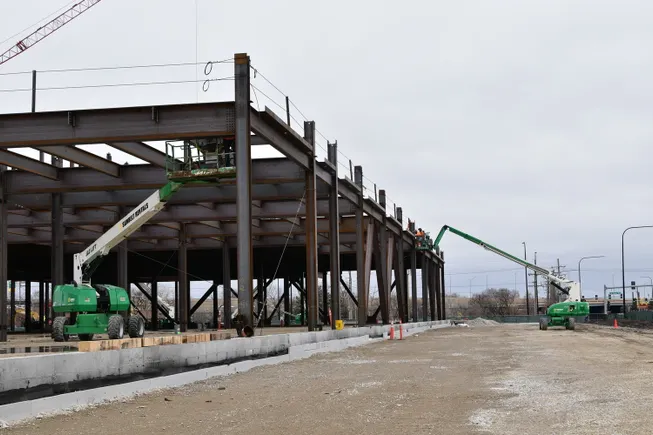Andrew Hime wants to bring predictability back to material sourcing.
Hime, the procurement manager at Clune Construction, joined the Chicago-based contractor in May as part of a broader push to build a national procurement strategy across the firm’s projects and markets. The approach aims to standardize how Clune engages suppliers, so project teams can rely on consistent cost certainty.
The newly created role comes at a time of heightened complexity in construction materials sourcing. Contractors across the country continue to grapple with long lead times and price volatility on key products.
Recent tariff hikes on aluminum, steel and copper, for example, have prompted domestic producers to raise prices. Input costs ticked up again in July, and now sit 2.6% higher for nonresidential construction compared to a year ago, according to the latest U.S. Bureau of Labor Statistics data.
Hime’s position focuses on easing that uncertainty and building long-term value for project teams. His past roles include chief procurement officer positions at Fermilab, a U.S. Department of Energy national laboratory based in Batavia, Illinois, and for Anne Arundel County in Annapolis, Maryland.
Here, Hime talks with Construction Dive about Clune’s purchasing strategy, tariffs and why to treat procurement as a strategic advantage opportunity.
This interview has been edited for brevity and clarity.
CONSTRUCTION DIVE: How are you adapting procurement strategy in light of the tariff situation, especially for sensitive materials?
ANDREW HIME: We stay incredibly close to the markets and work hand in hand with our trade partners to track not just current tariffs, but what’s likely to happen next.

Andrew Hime
Courtesy of Clune Construction
Our strategy is built around flexibility and early engagement. That means partnering with our operations team, clients, manufacturers and distributors to use market intelligence and develop sourcing strategies that minimize risk, whether it’s a pricing spike or a production delay on critical materials.
I often say, “We need to have the right tools in the toolbox.” In procurement, that means having the right contracts in place so we can meet the needs of any project, no matter what the market throws at us.
In data center or healthcare projects, how do you ensure materials arrive on time and prices stay under control?
These projects have little room for error.
Whether it’s delivering an MRI suite or energizing a critical IT load, we start early with demand planning and forecast modeling. This is especially true for materials with long lead times or volatile pricing.
It’s not just about securing materials, it’s about sequencing the right ones at the right time and understanding where we can’t afford delays.
We also build in backup plans, alternative vendors and transparent escalation paths when issues come up. Our procurement operation is not transactional. Much like everything at Clune, our strategy hinges on both actionable data and strong and collaborative relationships.
That helps us stay ahead of the curve and solve problems before they hit the schedule.
How does the approach of relying on a small group of trusted suppliers align with Clune’s strategy?
It’s part of our strategy, but we don’t approach it like a closed club. We’ve built strong national and regional vendor relationships based on shared expectations, performance, communication and accountability.
Those relationships give us leverage and reliability. The key to success in turbulent times is staying open to new and innovative solutions.
If a new vendor has something that brings value, we’ll vet them. We want partners who can grow with us and help us adapt, not only to meet the needs of a specific project, but to strengthen our supply chain and support the industry.
Are you seeing any new tools or technology that actually help with buying materials or planning ahead?
Yes, but we don’t fall for shiny objects.
The current global supply chain disruption unfolding around tariffs has created a significant opportunity for innovation in the space of procurement technology. Clune is taking that opportunity seriously and are looking to take major leaps that provide long-term value for our operations team as well as our clients.
Our strategy is to focus on investing in tools that improve visibility across industries and markets and bring simplicity to navigating long-lead items, material availability and cost fluctuations.
What signs do you look for that tell you prices might rise, or that delays might be coming?
There’s no one thing. It’s more like triangulating between global markets, vendor feedback and the on-the-ground reality.
We pay close attention to upstream supply chain trends, labor disruptions, raw material costs and sometimes geopolitical events. We also focus on predictive modeling so that when early warning signals start flashing, we pull together a cross-functional team to analyze risk and figure out if we should buy now or hedge.
We’d rather have the conversation early and be transparent with the client than wait until it’s a crisis.
Any other trends around procurement you are keeping tabs on?
More owners are realizing that procurement is a strategic lever and not just a cost center. We’re being brought in earlier during preconstruction and project planning phases to help mitigate risk, improve schedule certainty and advise on sourcing strategy.
That shift is good for everyone. It leads to better collaboration, better outcomes and fewer surprises once construction kicks off.
Also, sustainability is no longer a side conversation. Recent supply chain disruption combined with industry growth is sparking innovation and creativity to bring sustainability to be more central to the design and core requirements. Customers are exploring solutions that reduce energy consumption based on design and material requirements and combining projects with renewable energy sources.
We’re seeing more interest in how materials are sourced, transported, recycled and reused. We’re hoping that procurement has a bigger role to play in that evolution.
View the original article and our Inspiration here


Leave a Reply